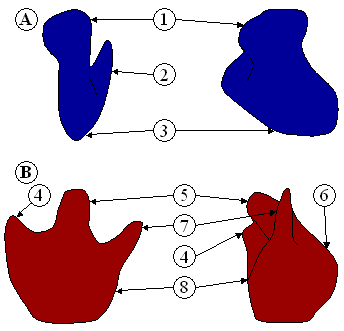Ribosome
|
|
A ribosome is an organelle composed of rRNA (synthesized in the nucleolus) and ribosomal proteins. It translates mRNA into a polypeptide chain (e.g., a protein). It can be thought of as a factory that builds a protein from a set of genetic instructions. Ribosomes can float freely in the cytoplasm (the internal fluid of the cell) or bind to another organelle called the endoplasmic reticulum. Since ribosomes are ribozymes, it is thought that they might be remnants of the RNA world.
| Contents |
Overview
Ribosomes consist of two subunits (Figure 1) that fit together (Figure 2) and work as one to translate the mRNA into a polypeptide chain during protein synthesis (Figure 3). Each subunit consists of one or two very large RNA molecules (known as ribosomal RNA or rRNA) and multiple smaller protein molecules. Experiments have shown that the rRNA are the crucial components in protein synthesis, and that one aspect of the process, peptide transfer, can occur in the presence of rRNA alone, albeit at a slower rate. This suggests that the protein components of ribosomes act as a scaffold that may enhance the ability of rRNA to synthesise protein.
The structure and function of ribosomes, and their attendant molecules, known as the translational apparatus, has been of ongoing research interest since the mid 20th century on through the early 21st century. A triennial conference is held to discuss the ribosome. In 1999, the conference was held in Elsinore, Denmark. The 2002 conference was held in Queenstown, New Zealand [1 (http://biochem.otago.ac.nz/ribocon/home.htm)].
Free ribosomes
Free ribosomes occur in all cells, and also in mitochondria and chloroplasts in eukaryotic cells. Several free ribosomes can associate on a single mRNA molecule to form a polyribosome or polysome. Free ribosomes usually produce proteins that are used in the cytosol or in the organelle they occur in.
Membrane bound ribosomes
When certain proteins are synthesized by a ribosome, it can become "membrane-bound", associated with the membrane of the nucleus and the rough endoplasmic reticulum (in eukaryotes only) for the time of synthesis. They insert the freshly produced polypeptide chains directly into the ER, from where they are transported to their destinations. Bound ribosomes usually produce proteins that are used within the cell membrane or are expelled from the cell via exocytosis.
The ribosomal subunits of prokaryotes and eukaryotes are quite similar. However, prokaryotes use 70S ribosomes, each consisting of a (small) 30S and a (large) 50S subunit, whereas eukaryotes use 80S ribosomes, each consisting of a (small) 40S and a bound (large) 60S subunit.[The unit S means Svedberg units, a measure of the rate of sedimentation of a particle in a centrifuge, where the sedimentation rate is associated with the size of the particle. Svedberg units are not additive - two subunits together can have Svedberg values that do not add up to that of the entire ribosome.]

In Figure 3, both ribosomal subunits (small and large) assemble at the start codon (the 5' end of the mRNA). The ribosome uses tRNA (transfer RNAs which are RNA molecules that carry an amino acid and present the matching anti-codon, according to the genetic code, to the ribosome) which matches the current codon (triplet) on the mRNA to append an amino acid to the polypeptide chain. This is done for each triplet on the mRNA, while the ribosome moves towards the 3' end of the mRNA. Usually, several ribosomes are working parallel on a single mRNA.
See also: protein assembly
Atomic structure
The atomic structure of the 50S large subunit ribosome from the archeal, Haloarcula marismortuia was published in Science on August 11, 2000 by N. Ban et al. Soon after the structure of the 30S was published in Nature on September 21, 2000 by BT Wimberly, et al. Using these coordinates MM Yusupov, et al were able to reconstruct the entire 70S particle in 2001.
| Organelles of the cell |
|---|
| Chloroplast | Mitochondrion | Centriole | Endoplasmic reticulum | Golgi apparatus | Lysosome | Myofibril | Nucleus | Peroxisome | Ribosome | Vacuole | Vesicle |
This article contains material from the Science Primer (http://www.ncbi.nlm.nih.gov/About/Primer) published by the NCBI, which, as a US government publication, is in the public domain [1] (http://www.ncbi.nlm.nih.gov/About/disclaimer.html).


